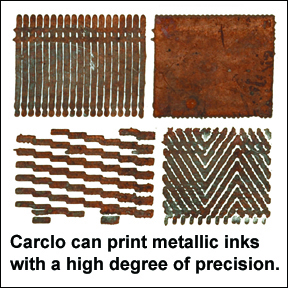As with many discoveries, this one happened by accident. Carclo, a British maker of high-performance injection-molded products for the automobile, medical and communications industries, developed a process to customize cell phones by printing personal photos on the plastic bodies. Motorola liked the concept and wanted to see if the digital printing technique could apply a photo—and the company’s logo—to one of its phones.
There was only one problem. “Motorola’s logo happens to be in a silver metallic ink,” says Mike Johnson, Carclo’s head of business development. “We went to the guy who runs the company that manufactures our print heads, and he said: ‘You’ve got to be joking. There’s no way you can get silver metal to go through digital print heads.'”
|
|
Unwilling to give up on a potential opportunity, Carclo hired Xennia Technology, which develops specialized inks, to find a way to print metallic inks with an inkjet printer. “Xennia came up with a novel approach that was technically very clever,” says Mike Johnson, Carclo’s head of business development. “I asked if they could also print copper, and a few weeks later, they said yes.”
Johnson knew just enough about RFID to figure out that the new printing technique could have an enormous impact on the technology. It could replace the etching process used for making most copper antennas, which is expensive and creates toxic waste.
Carclo developed a prototype printer that’s about the size of a small photocopier. It can print copper antennas on polycarbonate, polyester, polyethylene and other plastic films used for RFID tags, as well as on paper and cardboard. The copper layer can be as thin as half a micron and is almost as conductive as a solid copper antenna. And unlike bulk metal antennas, the printed antenna is recyclable.
The new digital inkjet printer could reduce the cost of tags and make it economically viable to print antennas on packaging during the commercial printing process. That’s because the process is fast—antennas can be printed at a rate of six feet per second—and it doesn’t require any extra steps, such as curing in an oven. Boxes could have antennas printed on them and, after drying for 30 seconds, go straight to the next stage of production.
The printing process also should make it easier to attach the antenna to the RFID microchip and provide a better bond. Most antennas are now printed using silk screens, which involves a two-step process: the antenna must be created and then the RFID microchip has to be placed in a precise position to ensure that two metal pads on the chip couple with the metal antenna electromagnetically. With digital inkjet printing, the chip can be placed on the carton or plastic film first, and the printer can print the antenna right over the metal pads, creating a direct physical bond.
Carclo and Xennia have formed a joint venture called CIT (conductive inkjet technology) to hold the patents for the new technology. Johnson says the company could have a production unit of the printer ready in six months, but it’s looking to partner with print and packaging companies that want to print RFID antennas; the process requires a web press, which CIT doesn’t want to invest in. Meanwhile, Carclo is still pursuing the idea of printing digital images on phones, but printed antennas may turn out to be its true calling.


